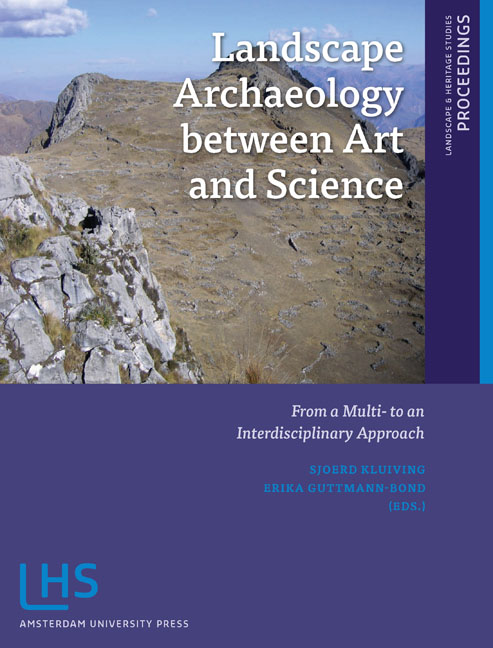Book contents
- Frontmatter
- Contents
- Preface
- Introduction: LAC2010: First International Landscape Archaeology Conference
- THEME 1 HOW DID LANDSCAPE CHANGE?
- THEME II IMPROVING TEMPORAL, CHRONOLOGICAL AND TRANSFORMATIONAL FRAMEWORKS
- THEME III LINKING LANDSCAPES OF LOWLANDS TO MOUNTAINOUS AREAS
- THEME IV APPLYING CONCEPTS OF SCALE
- THEME V NEW DIRECTIONS IN DIGITAL PROSPECTION AND MODELLING TECHNIQUES
- THEME VI HOW WILL LANDSCAPE ARCHAEOLOGY DEVELOP IN THE FUTURE?
- Miscellaneous Endmatter
4.2 - Surface Contra Subsurface Assemblages: Two Archaeological case Studies from Thesprotia, Greece
Published online by Cambridge University Press: 21 January 2021
- Frontmatter
- Contents
- Preface
- Introduction: LAC2010: First International Landscape Archaeology Conference
- THEME 1 HOW DID LANDSCAPE CHANGE?
- THEME II IMPROVING TEMPORAL, CHRONOLOGICAL AND TRANSFORMATIONAL FRAMEWORKS
- THEME III LINKING LANDSCAPES OF LOWLANDS TO MOUNTAINOUS AREAS
- THEME IV APPLYING CONCEPTS OF SCALE
- THEME V NEW DIRECTIONS IN DIGITAL PROSPECTION AND MODELLING TECHNIQUES
- THEME VI HOW WILL LANDSCAPE ARCHAEOLOGY DEVELOP IN THE FUTURE?
- Miscellaneous Endmatter
Summary
ABSTRACT
This paper focuses on two archaeological sites in the Kokytos valley in north-western Greece, discovered by the Thesprotia Expedition in 2004. We stress the discrepancies between surface and subsurface assemblages and try to explain these differences. Initially the sites were found and recorded in a surface survey. After this several multiscale datasets were obtained through different methods, e.g. phosphorus sampling, trial excavations and different geophysical techniques. In combining the different datasets it became quite clear that the surface assemblages are biased mainly through erosion and modern landscaping, but also due to so-called ‘walker effects’. Both sites proved to be more extensive in size and have a longer occupational time span when adding multiscale datasets to the surface collections made in the surface survey.
KEYWORDS
intensive survey, surface contra subsurface, post-deposition, hidden landscape, windows
INTRODUCTION
Anyone conducting an intensive archaeological field survey has been forced to consider to what degree an adequate picture of the past can be built on the basis of the finds detected on the surface. Or to put it another way: to which extent do surface assemblages concur with subsurface assemblages, and how can possible differences be explained and taken into account? Scholars working in the Aegean have in general believed that developments in the regional history could be constructed on the basis of surface assemblages, although at the same time being aware of the fact that such assemblages to some degree are shaped by post-depositional factors, the most common being erosion.
One of the first scholars to express doubt concerning the reliability of surface assemblages was Jeremy Rutter (1983, 138-139), who coined the expression ‘low-visibility ceramic phases’ for certain prehistoric periods that produced pottery less likely to be preserved and/or recognised. Bintliff, Howard & Snodgrass (1999, 139-168) brought the discussion further by suggesting that part of the prehistoric sites in Greece are not noted at all in intensive field surveys, thus creating a ‘hidden landscape’ that can be visualised only by increased attention. However, this explanation may be applicable only to certain regions of Greece, such as Boiotia (Davis 2004, 22-34). Nevertheless intensive field surveys are today often accompanied by other techniques, such as phosphorus sampling, different geophysical methods and occasionally even trial excavations.
- Type
- Chapter
- Information
- Landscape Archaeology between Art and ScienceFrom a Multi- to an Interdisciplinary Approach, pp. 295 - 306Publisher: Amsterdam University PressPrint publication year: 2012



